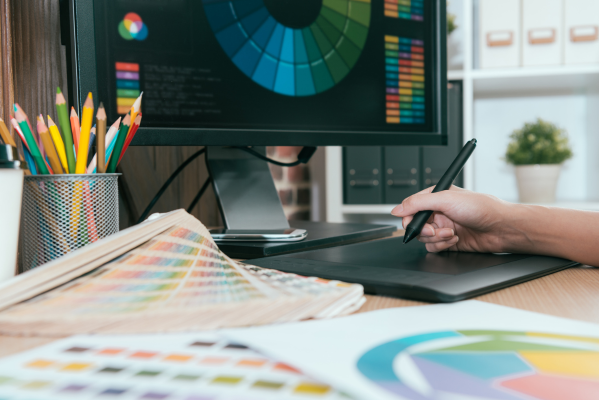In today’s highly competitive and rapidly evolving design industry, freelance designers must constantly strive to enhance their skills to stand out from the crowd. As a freelance designer, you have the freedom to pursue your passion, work on exciting projects, and shape your own career path.
However, to succeed in this dynamic landscape, it is crucial to continually improve your abilities, stay updated with the latest trends, and provide exceptional design solutions to clients. This article aims to provide valuable insights, tips, and tricks to help freelance designers enhance their skills and excel in their careers.
The design industry is characterized by ever-changing technologies, emerging trends, and evolving client demands. To thrive in such a competitive environment, it is essential to embrace lifelong learning. By continuously seeking new knowledge, exploring different design disciplines, and staying abreast of the latest industry developments, you can adapt and innovate, ensuring that your work remains relevant and impactful.
Developing a strong personal brand is another key aspect of enhancing your skills as a freelance designer. A well-defined personal brand helps you differentiate yourself in the market, attract the right clients, and communicate your unique design style and values. By showcasing your best work through a visually appealing portfolio and establishing a consistent online presence, you can build credibility and establish yourself as a trusted expert in your field.
Effective communication skills are vital for successful collaboration with clients and colleagues. As a freelance designer, you must be able to articulate your ideas, understand client requirements, and convey design concepts effectively. Clear and concise communication helps build strong client relationships, fosters a deeper understanding of project objectives, and ensures that your designs align with the clients’ vision.
Staying updated with design trends is paramount in the fast-paced design industry. Clients are often drawn to designers who can offer fresh and contemporary solutions. By keeping a finger on the pulse of design trends, you can infuse your work with current aesthetics, innovative techniques, and relevant functionalities. However, it is equally important to balance trends with timeless design principles and maintain a distinctive style that sets you apart.
Effective time management and organization skills are crucial for freelance designers who juggle multiple projects and deadlines. By prioritizing tasks, breaking them down into manageable chunks, and employing project management tools, you can optimize your productivity and ensure timely delivery of high-quality work. A well-organized workspace and a structured approach to managing your time allow you to maintain focus and avoid unnecessary stress.
Collaboration and seeking feedback are valuable growth opportunities for freelance designers. Collaborating with other designers, developers, or industry professionals exposes you to diverse perspectives, expands your knowledge, and helps you refine your skills. Seeking feedback from clients, peers, and mentors allows you to gain valuable insights, identify areas for improvement, and deliver designs that exceed expectations.
Investing in quality tools and resources is an investment in your professional growth and the quality of your work. High-quality design software, plugins, and resources streamline your workflow, enhance your capabilities, and contribute to the overall excellence of your designs. By equipping yourself with the right tools, you can work more efficiently, produce outstanding results, and demonstrate your commitment to delivering exceptional design solutions.
Expanding your skill set beyond your primary expertise can significantly enhance your versatility as a freelance designer. By acquiring complementary skills, such as web design, user experience (UX) design, or motion graphics, you can broaden your service offerings and cater to a wider range of client needs. This expansion not only diversifies your portfolio but also positions you as a well-rounded designer capable of tackling multifaceted projects.
Embrace Lifelong Learning
Design is a field that is constantly evolving, with new trends, technologies, and techniques emerging regularly. To stay relevant and enhance your skills, embrace lifelong learning. Dedicate time to expand your knowledge by reading design blogs, books, and industry publications. Take online courses or attend workshops to learn new software, design principles, or specialized techniques. Engage in online design communities and forums to exchange ideas and gain insights from fellow designers. Embracing continuous learning will keep your skills sharp and enable you to offer innovative solutions to clients.
Develop a Personal Brand
As a freelance designer, developing a personal brand is crucial for standing out in a competitive market. Define your unique style, values, and design philosophy. Create a visually appealing portfolio that showcases your best work and highlights your strengths. Establish a consistent online presence through a professional website and social media profiles that reflect your brand identity. Actively engage with your audience by sharing your design process, insights, and expertise. Building a strong personal brand not only attracts clients but also establishes you as an authority in your field.
Cultivate Effective Communication Skills
Effective communication is key to success as a freelance designer. Develop strong verbal and written communication skills to articulate your ideas, understand client requirements, and collaborate effectively. Actively listen to clients to grasp their vision and provide tailored design solutions. Clearly communicate project timelines, deliverables, and any potential challenges upfront to manage expectations. Be receptive to feedback and incorporate it into your work. Effective communication fosters positive client relationships and ensures client satisfaction.
Stay Updated with Design Trends
Design trends evolve rapidly, and clients often seek designers who are up-to-date with the latest industry developments. Stay informed about current design trends, both in terms of aesthetics and functionality. Follow design influencers, attend design conferences, and explore design showcases to stay inspired. However, exercise discernment and adapt trends to suit your style and the specific needs of each project. By staying updated with design trends, you can create contemporary and visually appealing designs that resonate with your target audience.
Master Time Management and Organization
As a freelance designer, managing your time efficiently and staying organized is crucial for productivity and meeting deadlines. Prioritize tasks based on urgency and importance, breaking down larger projects into manageable milestones. Use project management tools or productivity apps to create schedules, set reminders, and track progress. Establish a workspace that fosters focus and minimizes distractions. Effective time management allows you to deliver high-quality work on time, impress clients, and maintain a healthy work-life balance.
Collaborate and Seek Feedback
Collaboration and feedback are invaluable for growth as a designer. Seek opportunities to collaborate with other designers, developers, or experts in related fields. Collaborative projects provide fresh perspectives, enhance your skills, and expand your network. Additionally, seek feedback from clients, peers, and mentors to gain insights into areas of improvement. Constructive feedback helps refine your design approach and ensures client satisfaction. Be open to constructive criticism, as it paves the way for growth and improvement.
Invest in Quality Tools and Resources
As a freelance designer, investing in high-quality design tools and resources is essential to produce professional-level work. Stay updated with the latest design software and plugins that streamline your workflow and enhance your capabilities. Explore online marketplaces for design assets, such as fonts, icons, and templates, to enhance your designs efficiently. Quality tools and resources save time, elevate the quality of your work, and demonstrate your commitment to excellence.
Expand Your Skill Set
As a freelance designer, expanding your skill set beyond your primary expertise can open up new opportunities and make you a more versatile professional. Identify complementary skills that align with your design niche and invest time in learning and practicing them. For example, if you specialize in graphic design, consider acquiring skills in web design or user experience (UX) design. This expansion not only allows you to offer a broader range of services to clients but also positions you as a well-rounded designer with a holistic approach. Explore online tutorials, courses, or mentorship programs to gain proficiency in these new areas. Additionally, seek out challenging projects that require you to stretch your skills and push boundaries. By expanding your skill set, you can differentiate yourself from other designers and attract clients seeking comprehensive design solutions.
Conclusion
Enhancing your skills as a freelance designer is an ongoing journey that requires dedication, adaptability, and a thirst for knowledge. By embracing lifelong learning, developing a personal brand, cultivating effective communication skills, staying updated with design trends, mastering time management, seeking collaboration and feedback, and investing in quality tools and resources, you can elevate your skills and thrive in your freelance design career. Remember, the pursuit of excellence is a continuous process, and by continuously improving your skills, you can deliver exceptional design solutions, attract more clients, and enjoy a successful and fulfilling freelance design career.



